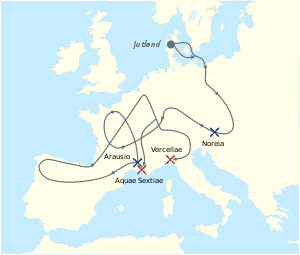This article needs additional citations for verification. (April 2024) |
| Battle of Arausio | |||||||
|---|---|---|---|---|---|---|---|
| Part of the Cimbrian War and Roman–Germanic Wars | |||||||
 The migrations of the Cimbri and the Teutons. | |||||||
| |||||||
| Belligerents | |||||||
|
Cimbri Teutons | Roman Republic | ||||||
| Commanders and leaders | |||||||
|
King Boiorix King Teutobod |
Quintus Servilius Caepio Gnaeus Mallius Maximus | ||||||
| Strength | |||||||
| 200,000 |
120,000
| ||||||
| Casualties and losses | |||||||
| 15,000 killed | Possibly total | ||||||
Location within France | |||||||
The Battle of Arausio took place on 6 October 105 BC, at a site between the town of Arausio, now Orange, Vaucluse, and the Rhône river, where two Roman armies, commanded by proconsul Quintus Servilius Caepio and consul Gnaeus Mallius Maximus, were heavily defeated after clashing with the migratory tribes of the Cimbri under Boiorix and the Teutons under Teutobod.
Differences between the Roman commanders prevented regular coordination between their armies, resulting in annihilation by the united Cimbrian-Teutonic force. Roman losses are thought to have been up to 80,000 legionaries in addition to 40,000 auxiliary troops. Total losses numbered up to 120,000 soldiers, the entirety of both armies. In terms of losses, this battle is regarded as the worst defeat in the history of ancient Rome,[2] surpassing the Battle of Cannae. According to classical historians, as a direct result of the catastrophe, the Roman military was supposedly restructured under Gaius Marius via putative reforms to the organisation and recruitment of Roman legions, which would remain principally intact for centuries thereafter. Some modern historians contest the existence of sudden reforms under Marius.[3]
- ^ ᾖν δὲ πρὸ μιᾶς νωνῶν Ὀκτωβρίων "it was one day before the nones of October" Plutarch, Parallel Lives, Life of Lucullus 27.7
- ^ "Battle of Arausio, 6 October 105 BC". www.historyofwar.org.
- ^ "Collections: The Marian Reforms Weren't a Thing". 30 June 2023.

